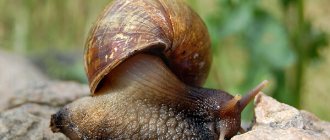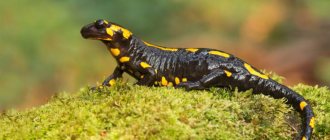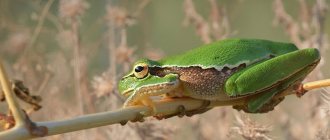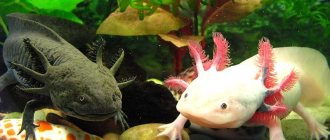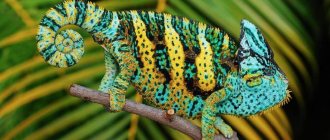The gecko is a small lizard that lives in subtropical and tropical regions. She has amazing limbs. The animal's paws are covered with many hairs, thanks to which the lizard can walk on vertical surfaces, such as walls, window panes and even the ceiling. There are a large variety of geckos. They differ from each other in color, size and body structure.
Description and external features
The size of African lizards can vary from 3 to 30 centimeters. The eyes are protruding and large. A characteristic feature of the appearance is the absence of eyelids.
The skin of geckos is delicate and sensitive, and is therefore covered with protective scales.
The lizard's tail is thin and has the ability to regenerate.
The lower part of the paws is covered with numerous hairs, thanks to which the gecko can move easily and freely on both horizontal and vertical surfaces.
The color is bright and changing, depending on the time of day, the condition and mood of the animal.
Geckos are primarily nocturnal.
One of their most interesting features is the ability to produce a wide variety of sounds.
Cleaning the terrarium
Clean the water section of your lizard's tank daily. Your pet will likely go into hiding in another corner of the tank, so it will be easy to just scoop up any solid waste with a small scoop. Also, remove the wet substrate.
Clean and disinfect the tank completely weekly. In this case, you need to remove the gecko from the tank and place it in a reserve tank or some other container from which it cannot escape. Wash your hands; you can also wear disposable gloves. Remove everything from your home. Clean the aquarium with hot, soapy water, or you can use a scraper. Use lizard disinfectant. Follow the manufacturer's instructions. Make sure everything is completely rinsed with water and completely dried. Always wash your hands well with hot, soapy water after cleaning your lizard's tank. If you have used gloves, it is best to throw them away.
Conditions of detention
To keep a gecko at home, you need to purchase a spacious, not too high, horizontal terrarium.
The ideal soil option is gravel or sand. It is important to take care of sufficient moisture in the terrarium.
Since African lizards need periodic solitude, shelters should be placed at the bottom, which can be either special houses or improvised objects (for example, halves of a coconut).
A drinking bowl with clean water should always be present in the terrarium.
To maintain a suitable microclimate, it is recommended to install pots with greenery.
Optimal temperature indicators range from +19 to +34 C. Moreover, in the daytime, the temperature should be slightly higher than at night. An incandescent lamp will help provide the necessary heating.
Recommended humidity levels are about 70-80%. To moisturize, the terrarium should be sprayed periodically, using fresh water for this purpose.
Despite the fact that reptiles are nocturnal, a fluorescent lamp must be installed next to the terrarium.
It is necessary to irradiate lizards with ultraviolet light at least 1–2 times a week, otherwise their health and appearance will noticeably deteriorate.
In their natural environment, geckos live in small colonies and do not tolerate loneliness well. For this reason, it is recommended to keep them at home in pairs.
The best option is 1 male and several females.
But it is strictly not recommended to place 2 males in one container, since the fight for territory leads to serious fights and, in most cases, ends in the death of one of the animals.
Mr. Tail recommends: varieties
The Gecko family includes more than a thousand species. When looking for a lizard for home keeping, it is recommended to choose from those listed in the table:
| Name | a brief description of |
| Mediterranean | The body length of males is about 4.5 cm; females can grow 0.5 cm longer. The upper part of the body is gray or light brown. There are black stripes across the body in the shape of the letter M. Strong flattening of the head and body. |
| Broad-tailed felsuma | The body of adult geckos is from 10 to 13 cm in length. They are capable of changing color from light green to green with a hint of yellow. There are 2 red stripes on the head, and 3 large red areas on the part of the body closer to the tail. |
| Madagascar daytime | It has a light or rich green color. The body length in males can be 30 cm, in females it can be several cm less. The nostrils are red, and there are stripes of the same color on the muzzle. There are red stripes near the tail. |
| Flat-tailed | Geckos come in a variety of colors, from brown and gray to green and orange. There is a white stripe under the eyes. The length of adult reptiles is 10-14 cm. The tail can make up up to 50% of the entire body. |
| Yellowhead dwarf | Reptiles grow no more than 9 cm. Body color is gray or deep blue with a sharp transition to yellow and dark stripes near the head. In females the transition is less contrasting than in males. |
| Spadetail | The body is strongly compacted, and there are scalloped outgrowths on the tail. Thanks to the fringed longitudinal fold, it can cover long distances in a jump. The body is gray with black and white patterns. |
| Indian (viper) | An adult specimen is no more than 10 cm long. The body is decorated with gray-brown stripes with small light spots, and the tail is thick and carrot-shaped. |
| Skink | Banana or light green body up to 20 cm in size. Several dark stripes run along the back and sides of the body. The belly is light yellow. Characterized by thin skin. |
| Feline | Individuals are dark brown with a small amount of red. Triangle-shaped muzzle, enlarged black eyes. They grow within 10-17 cm. The fingers are elongated and have claws. Increased body flexibility. |
| Central Asian | Light red body with dark spots from head to tail. The limbs are duller in comparison with the rest of the body. Large paws have claws. |
| Ciliated Baneater | Adult geckos grow up to 12-20 cm. The head is triangular, together with the body it is strongly flattened. The color can be beige or rich brown, and there are black stripes on the body. When a tail is lost, the formation of a new one is not observed. Characterized by thick skin. |
| Currents | Weighs up to 300 g with a length of about 36 cm. The upper part of the body is gray or blue with many red and white spots. Characterized by very strong jaws. |
Feeding
The gecko is a predator by nature. When learning how to keep an exotic pet at home, you should pay special attention to nutritional issues. The basis of the diet of an African lizard in captivity should be:
- Crickets.
- Mealworms.
- Cockroaches.
- Flies, spiders.
- Small rodents.
It is recommended to dilute live food with berries, cottage cheese, fruits, and quail eggs.
Geckos should be fed no more than 2 times a week.
It is strictly not recommended to overfeed your pets. Overeating has an extremely negative impact on the health of the reptile, leading to apathy, decreased motor activity, the development of a number of diseases and causes the animal’s premature death.
Currents
This is a fairly large lizard. Toki gecko (adult) reaches 35 cm in length. Males are brighter colored than females. Their backs can be olive, gray or dark green, with white patches that turn into stripes on the back. The eyes are large with vertical pupils. The body is dense, slightly flattened. The head is very large, powerful but short legs. The tail is not too long.
The toki gecko is common in tropical forests in southeast Asia. This reptile gives the deceptive impression of a clumsy creature. In fact, she is very active, especially at dusk. Toki are aggressive towards their fellows. Strangers are not allowed into their territory. They declare their right with a loud cry.
Character and communication with your pet
When planning to have such an unusual, exotic pet, you should remember that African lizards are wild predators.
They have strong jaws and sharp teeth that are difficult to open without damaging them.
Geckos have a hard time with intrusion into their personal space and can become aggressive, swell and hiss loudly.
It is strictly not recommended to try to pick them up at such moments, as this may result in injury.
However, the gecko gradually gets used to the person who cares for it and gives it food. However, you should not hold your pet too often, so as not to provoke the development of severe stress.
When caring for or interacting with an animal, you must be especially careful with the tail, which, due to its natural thinness and fragility, can come off.
In general, the gecko is a fairly peaceful animal, but you should not unceremoniously invade its personal space, especially during mating games, eating or resting.
Compatibility
A pair of Geckos is a suitable choice for keeping if you plan to breed reptiles. It is allowed to add 2-3 females to one male in order to bring the conditions closer to natural and fully satisfy the male’s sexual desire.
Setting up a terrarium for two males is dangerous, as clashes will regularly occur between them, which can result in injury, loss of tail, stress, and even death of the weaker one. This recommendation applies to members of the same species as well as different ones - sometimes Geckos may consider Tropicolotes (Dwarf Israeli Geckos) as prey.
You can avoid problems with the help of partitions, but they complicate the operation of the tank.
Advantages and disadvantages of keeping geckos at home
Keeping an African lizard at home is not a particularly troublesome task. These pets have the following advantages:
- Cleanliness - to maintain order in the terrarium, it is enough to clean it 1-2 times during the week.
- Absence of any unpleasant, specific odors.
- Bright, unusual appearance and interesting character, making observing the reptile extremely exciting.
- No need for frequent feeding - an adult lizard can easily go without food for 4-5 weeks.
- Friendliness and peaceful nature.
- Possibility of reproduction in captivity.
It is also important that geckos are very pleasant to the touch and do not cause allergic reactions in humans, so they can become an excellent pet for people who are allergic to cat and dog hair.
As for the disadvantages of keeping geckos at home, they usually include the nocturnal lifestyle of the reptile. During the day, the lizard usually sleeps, hides in shelters and is not active, but at night, on the contrary, it can disturb the sleep of its owners by making loud sounds.
In addition, the gecko is a fairly expensive animal, the average cost of which varies from 100 to 1000 dollars and even higher if we are talking about rare subspecies.
The gecko is a beautiful reptile that can become a real decoration of the room. Knowing how to keep such an unusual pet at home, you can admire its bright, tropical appearance and funny habits for decades.
Reproduction
In nature, individuals are ready to mate all year round, except winter. As a result, the female begins to look for hollows in trees where she can lay eggs. Most often, 6-8 clutches are obtained with a frequency of 30 days. Incubation takes from three months to six months - it all depends on environmental conditions.
Before propagation, you need to place large pieces of bark and small trunks with hollows in the terrarium. The number of offspring also depends on how many places for laying the female can find.
In order for offspring to appear, the temperature in the tank must be maintained at +30 °C. If everything is done correctly, incubation will take approximately 4.5 months. At this time, the female’s body needs as many minerals as possible, including calcium. Otherwise, she will start gnawing on the shell.
A couple of months after laying the eggs, the offspring should be transferred to a separate incubator. This is done for its protection - so that adult individuals cannot eat newly hatched ones. Insect larvae and crickets are suitable for feeding small Geckos.
Most gecko species do not have eyelids, so they lick their eyes to clean them.
If you didn't have eyelids, you could also resort to this cleansing and moisturizing method. Ian Schofield/Shutterstock
Perhaps one of the strangest facts about geckos is that most species do not have eyelids. Since geckos cannot blink, they lick their eyes to keep them clean and moist. (Well, technically they lick the clear membrane that covers the eyeball.)
"Foton-M"
On this Russian biosatellite, five geckos were launched into space orbit - 1 female and 4 males, fruit flies, mushrooms, seeds of higher plants, and silkworm eggs. The purpose of the experiment in lizards is to study the effect of microgravity on the sexual behavior of animals, embryonic development and the production of offspring from medium-sized geckos. The flight was designed for 60 days.
Unfortunately, all the geckos in space died. Presumably they froze as a result of a failure of the satellite's heating system.
Based on the remains, scientists cannot accurately determine the reasons for the death of the reptiles. But they claim that the geckos in space died quite early - about a week before landing. Their bodies were partially mummified. Many researchers believe that hypothermia is just one of the possible versions.
Some more interesting facts
Another unique feature of the gecko is that it does not need to take baths. All dirt, dust and debris fall away under the influence of atmospheric moisture. After a series of studies, it was found that they have small hairs on their skin that create air pockets, as a result of which moisture washes away all the dirt from the body. Such a hydrophobic surface is characteristic exclusively of insects and plants, and among vertebrates only the gecko has it. Despite such unique features, gecko lizards still do not know how to fish. By the way, this question was asked in the program “Who Wants to Be a Millionaire?” (broadcast on 12/30/17).
At the same time, scientists use a “water gun” to catch this reptile. After getting wet (what gecko lizards can’t do?) – they practically cannot move until the water drains.
Due to their craftiness, lizards quickly spread throughout the world. In the suitcases of travelers they came from Turkey to Central America and to the USA, by the way, they took root perfectly and formed large populations. However, not all species can boast of such vitality; some individuals are already listed in the Red Book. And there are such unique species that only a couple of individuals have been caught in history. Back in 1956, a reticulated ground gecko was discovered in the United States; the second representative of this species was caught only in 1971.
Geckos' toes help them stick to any surface except Teflon.
The sticky toe pads of geckos are a major source of inspiration for biomimicry. nico99/Shutterstock
One of their most famous talents is the ability to run on smooth surfaces - even glass walls or ceilings. The only surface that geckos cannot stick to is Teflon. Well, dry Teflon. However, add water and geckos can even stick to this seemingly impossible surface! They do this with special pads on their toes. ()
Contrary to popular belief, geckos do not have sticky toes, as if they were covered in glue. They cling with incredible ease thanks to nano-sized hairs known as bristles that line each toe in huge numbers. It is reported that the 6.5 million bristles combined on a single gecko can generate enough force to support the weight of two people.
This fantastic gecko adaptation has inspired scientists to look for ways to mimic this clinging ability, improving everything from medical bandages to self-cleaning tires.
Where to buy a gecko
Every store selling animals has a selection of reptiles. The gecko is a popular lizard, so their choice is always quite varied. In Moscow, we advise you to contact the Gekko terrarium workshop. This is a specialized pet store that deals exclusively with terrarium animals. In addition, here you can pick up all the necessary equipment and accessories for keeping reptiles. These include terrariums of different sizes from different manufacturers, lamps, heating devices, and heating mats. Here you will be offered various types of soil, select plants, drinking bowls and waterfalls, and select dry and live food. In the Russian capital, you can go to the Happy Gecko Farm nursery for lizards; in St. Petersburg, you can go to the Living Water salon or the Priroda store. There you can buy everything you need for these pets.
Vision
The reptile has an almost perfect organ of vision. From a long distance, it can see both small prey and large predators. The eyeballs themselves are quite large when compared to the size of the head. However, the eyes do not have eyelids, but only a special shell that cleans them. If this is not enough, then the animal uses its tongue. Accordingly, what gecko lizards cannot do is blink.
Another interesting feature: the lizard's pupil has several pinholes, each of which can independently focus on a separate object, transmitting a clear image to the retina. Then the pictures are connected and a full picture is reproduced.
Eating in a natural environment
Gecko lizards do not catch fish or eat them, this is a fact. One thing we can definitely say about these reptiles is that they are very voracious. If an animal overeats, then all the fat is deposited in the tail. In nature they use:
- worms;
- larvae;
- cicadas;
- butterfly caterpillars;
- cockroaches;
- small midges.
Large animals can consume scorpions, small mice, frogs and young snakes, even small chicks.
The only thing reptiles do not eat is vegetation, as they are predators. In cities with a subtropical climate, geckos even settle in houses and apartments; they noticed that the light emitted by electric lamps attracts insects, therefore, you can eat well, the main thing is to find a good wall.
And in South America, reptiles learned to live in caves with bats. In the habitats of mice there is a lot of droppings, which attract cockroaches, which are then eaten by geckos.




